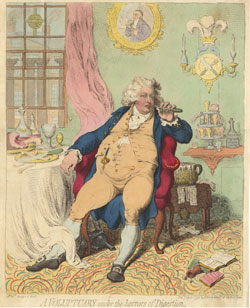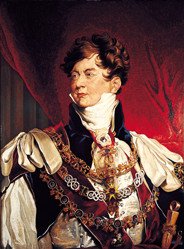
Until they reached the turnpike gate,
Where a coach had made a stop;
So they both got upon the top,
And after their disastrous falls,
At length in safety reached St. Paul’s.

 One of my favorite descriptions of the Regency dandy, and one that I contributed to Wikipedia, is the following in which author Venetia Murray quotes an excerpt from An Exquisite's Dairy, from The Hermit in London, 1819:
One of my favorite descriptions of the Regency dandy, and one that I contributed to Wikipedia, is the following in which author Venetia Murray quotes an excerpt from An Exquisite's Dairy, from The Hermit in London, 1819: Beau Brummell, image from the British Library
Beau Brummell, image from the British Library
 Upon My Word! Regency Fact and Figures
Upon My Word! Regency Fact and Figures
Also on this blog: Male Bastions: The Clubs of St. James's



During the period of his greatest popularity and influence, Beau Brummell (depicted above) held court in the Bow Window at White's in full view of the public. White's was founded in 1693 as a Chocolate House. By the end of the 18th Century, the popularity of chocolate houses declined, and many of the exclusive chocolate houses became Gentleman's Clubs.
Find more information about Gentlemens Clubs in the following:
 In The Corinthian, Georgette Heyer describes Sir Richard in her inimitable fashion:
In The Corinthian, Georgette Heyer describes Sir Richard in her inimitable fashion:In High Society: A Social History of the Regency Period, 1788-1830, Venetia Murray writes:
"...admirers of dandyism have taken the view that it is a sociological phenomenon, the result of a society in a state of transition or revolt. Barbey d'Aurevilly, one of the leading French dandies at the end of the nineteenth century, explained: Some have imagined that dandyism is primarily a specialisation in the art of dressing oneself with daring and elegance. It is that, but much else as well. It is a state of mind made up of many shades, a state of mind produced in old and civilised societies where gaiety has become infrequent or where conventions rule at the price of their subject's boredom...it is the direct result of the endless warfare between respectability and boredom.
In Regency London dandyism was a revolt against a different kind of tradition, an expression of distaste for the extravagance and ostentation of the previous generation, and of sympathy with the new mood of democracy.
